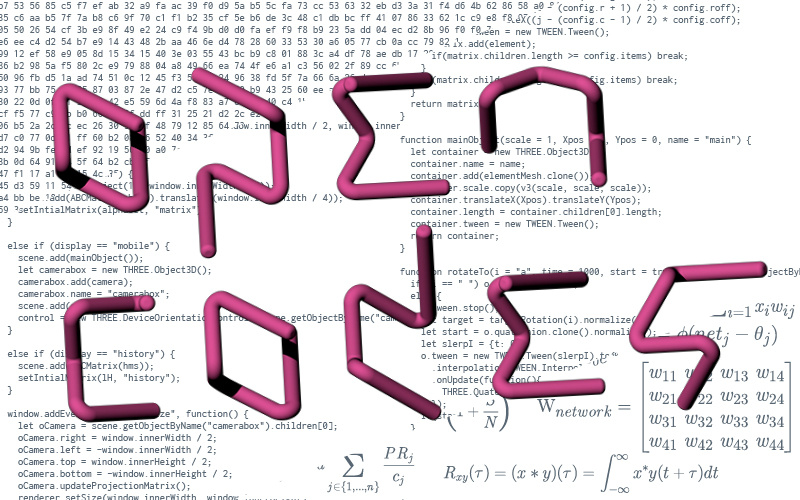Fragments of Dark Matter Life
Thu, November 23 – Sun, November 26, 2017
- Location
- OpenHUB, Atrium 8+9
- Meeting Point
- Fragments of Dark Matter Life
With luminous, vibrating stars as detectors, we investigate and reveal the hidden signatures of invisible Dark Matter permeating the Universe and its way of manifesting the invisible in terrestrial life, from astrophysics, the Arts , philosophy to cognitive sciences until rethinking to the laboratory-archive-museum-life . All this, in order to elaborate and experiment new tools and new attitudes for research and the diffusion of knowledge itself.
| Thu, November 23 and Fri, November 24, 2017 | 3 pm–6 pm |
| Sat, November 25 and Sun, November 26, 2017 | 11 am– 2 pm |
Freddy Paul Grunert
1st Day (Thu, November 23, 2017):
- Nobel shift, from Uppsala to the stars
- Observations from the changing paradigma in science and media art
2nd Day (Fri, November 24, 2017):
- In Tamburini's dark matter paper stars are the detectors to the invisible
- New dimensions in the research of the unseen, considering new neuro- and cognitive researches from Radical Embodied Cognitive Science to the the Blue Brain Project
3rd Day (Sat, November 25, 2017):
- Eretics in science: from Roger Penrose to Frank Wilzek to Tamburini's sculpting light and the European Commission Program SciArt
4th Day (Sun, November 26, 2017):
- Conclusions considering deep theory and deep history, considerations about our common work Fabrizio Tamburini, Cristina Fiordimela, F.P. Grunert in Scientist in Residence Program; the interactive Installation SOL in the ZKM Panoramascreen (Code-n ) and proposals for other interactiveness in dark matter, big data
Fabrizio Tamburini
1st Day (Thu, November 23, 2017):
Why dark matter? Zwicky in 1933 pointed out the discrepancy between the dynamical and luminous matter in the Coma cluster of galaxies stressing the need for some form of Dark Matter. The gravitational and luminous matter signatures are clearly separated in many cases, like in galaxy rotation curves and gravitational lensing and in the formation of cosmic structures. During these years many experiments and theoretical efforts improved our knowledge both in data collecting, analysis and theory with a been tremendous progress.
Recently, using stars as detectors, we were finally able to give a possible experimental evidence to this elusive part of the universe.
2nd Day (Fri, November 24, 2017):
Change of paradigms science, art and mediatechnology - part one.
How new ideas can be born. What is the correct approach to an »unsolvable« problem? Some examples such as vorticities, dark matter search and challenges to impossible problems can be faced by using different perspectives.
3rd Day (Sat, November 25, 2017):
Experiencing the change of paradigms science, art and mediatechnology - part 2 - perspectives for future research.
Cristina Fiordimela
The Unit Art/Science/Exhibition-Communication Fields.
1st Day (Thu, November 23, 2017):
The progressive development and approach in Art and Science gives new impulses to science and art communication in museography. Nowadays the revealed intrinsic common practice in art and science gives new impulses to a field of keywords through which we can experience concepts and practice in the triangle of art/science/space.
Introduction speaking of metalanguage art/science exhibition-communication fields: recent theories.
The first target of the introductional séance is to map across a resonate bibliography the transformation of space in the unity of art/ science / space linked to perception / participation as an cognitive sensorial experience.The keywords found will have the function of media- tools to get access what the paper of Fabrizio Tamburini reveals in relation to dark matter.
The incipit is the concept of artificial space-medium in Macdonald S., Silverstone R. »Science on display: the representation of scientific controversy in museum exhibitions«, Durant J. Museums and Public Understanding of Science (1992) as an introduction to an excursus in museography: Public Intimacy, Architecture and Visual Arts, by Bruno G. (2007) .
Even Chaumier S. Jacobi D., Exposer des idées (2009), follows this interpretation adding his idea of Ambiance by Chelkoff G. (2nd International Congres of Ambiance, Montréal 2012), conducting to the most recent experiences di museum-medium-agorà.
2nd & 3rd Day (Fri, November 24, 2017 and Sat, November 25, 2017)
The key-words of the first session open to new experiences and projects focusing to a field of new attitudes following the fenomenological Unit of art/science/space.
The Investigation take advance of manifold tools: such as notational systems in notes, writings, images , performance related to space tracing the interferences to text/images/body, beyond the taxonomy in museography.
First examples start with the ’Exploratorium of San Francisco to Pasadena's Symposium From Cybernetics to Museology, a Series of Talks and Performances Links Art and Science (2017).
